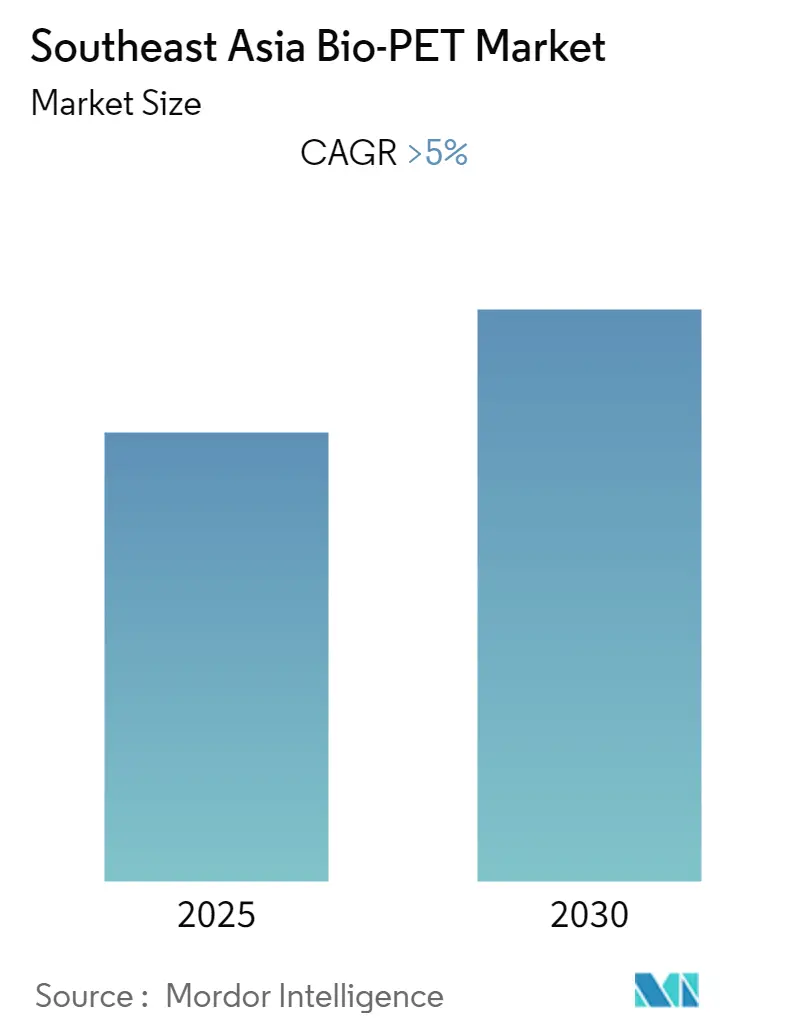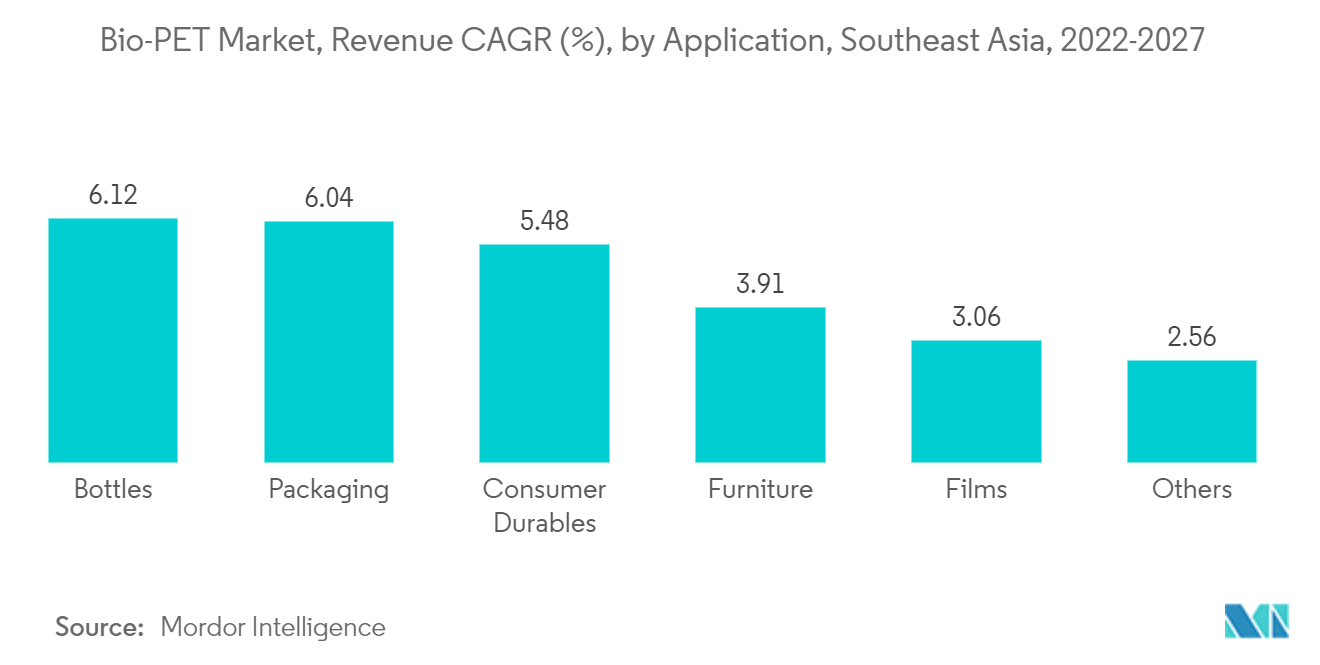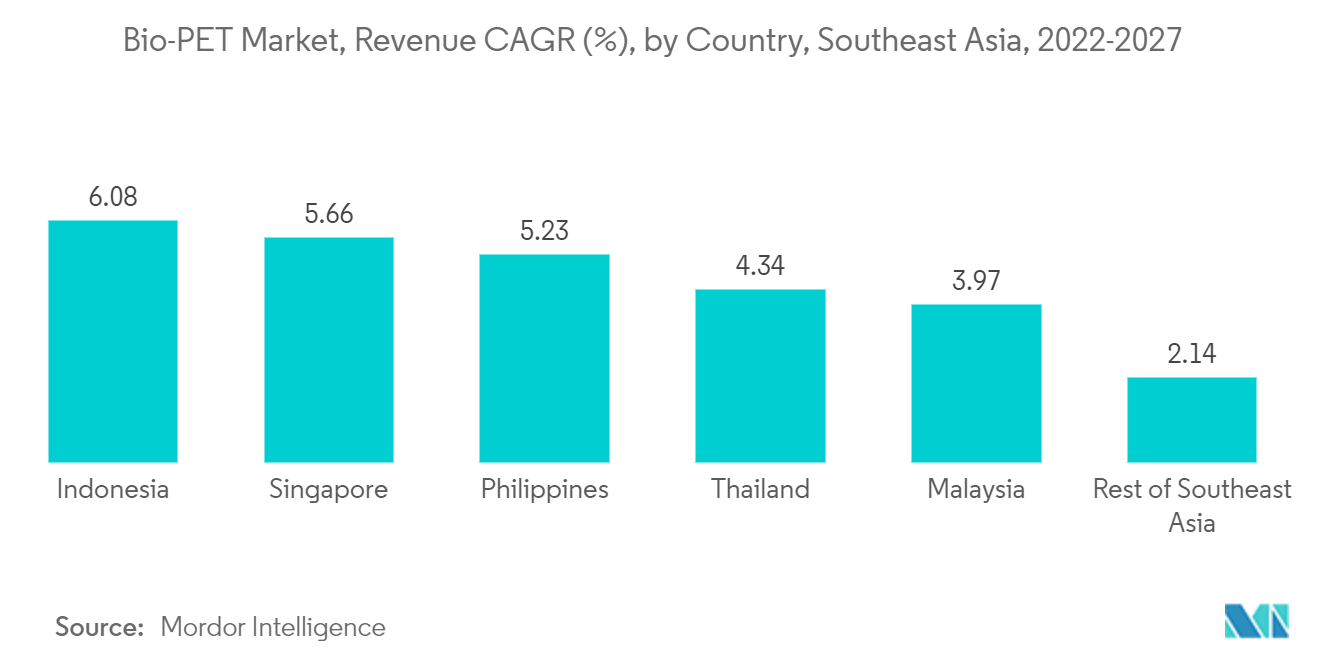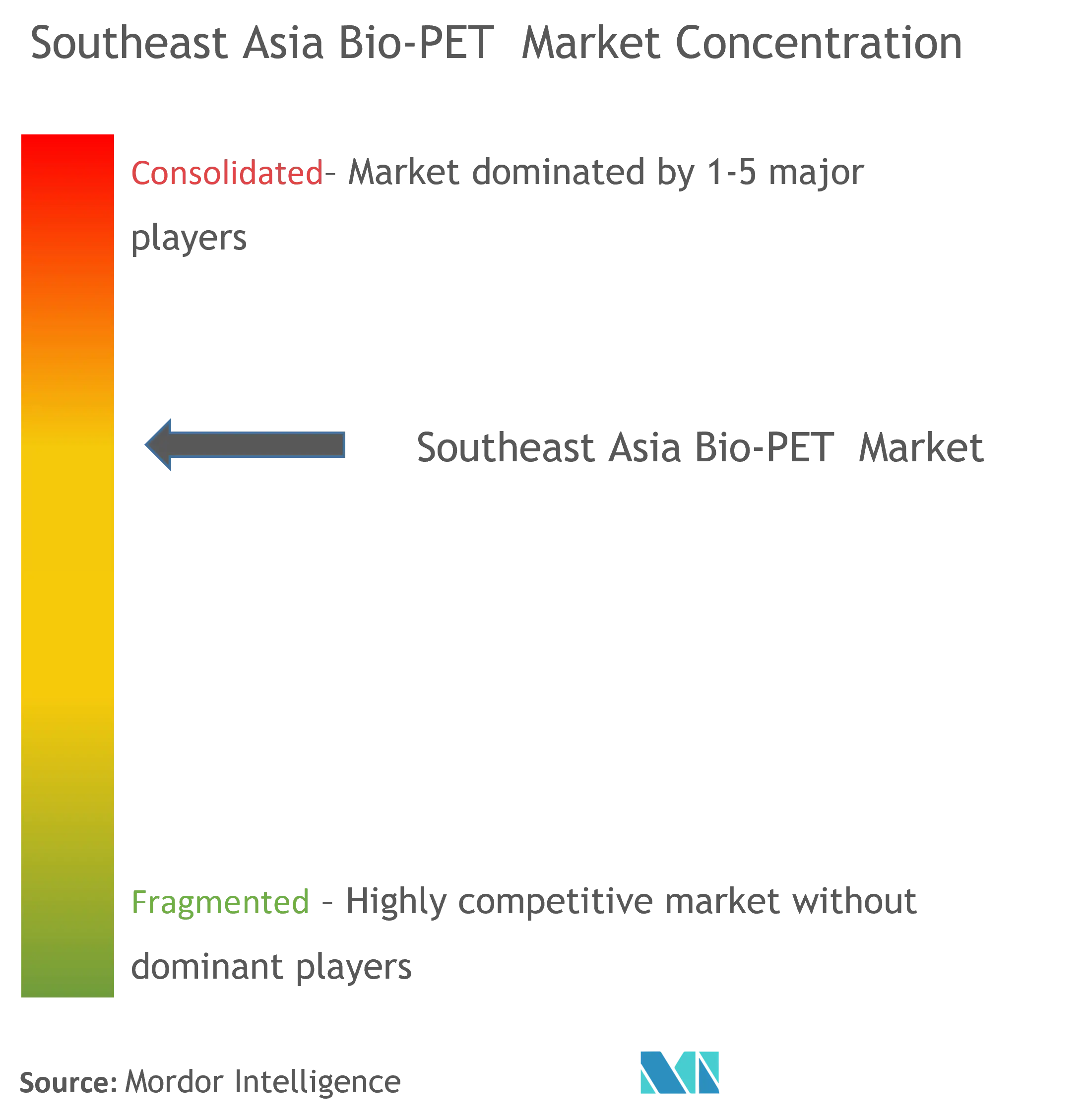
Southeast Asia Bio-PET Market Analysis by Mordor Intelligence
The Southeast Asia Bio-PET Market is expected to register a CAGR of greater than 5% during the forecast period.
The COVID-19 pandemic has significantly impacted the bio-PET market by affecting production and demand, creating supply chain and market disruptions, and financial impact on firms and financial markets. COVID-19 has led to negative consequences in the Bio-PET manufacturing market. However, the market has recovered in the two years, and companies have formulated strategic decisions to gain a competitive edge.
- Over the short term, the major factors influencing the market are the growing concern about greenhouse gas emissions and environmental factors promoting the paradigm shift, likely to increase the demand for Bio-PET during the forecast period.
- However, the development of Polyethylene Furanoate (PEF) will likely restrain market growth.
- Nevertheless, focusing on renewable sources will likely act as an opportunity over the forecast period.
Southeast Asia Bio-PET Market Trends and Insights
Bottles Application to Dominate the Market
- In 2021, PET bottles accounted for about 45% of Southeast Asia's soft drinks packaging unit volume. Bottles application contributed to the major share of the PET market, and bio-PET can be preferably used for producing bottles in the near future.
- The increase in demand for bio-PET is especially from soft drink manufacturers of those regions, such as Pepsi Co. and Coca-Cola. These companies are investing huge resources in producing bio-PET, thus driving the market growth.
- Bio-PET is made from renewable raw materials, is considered less harmful, and is likely to boost bottle application growth in the Southeast Asia bio-PET market.
- All the above attributes will likely drive market growth during the forecast period.

Indonesia Dominates the Market
- The increasing demand for bio-based PET has resulted from the increased use of eco-friendly products and strict environmental guidelines promoting the usage of bio-friendly products in the packaging industry.
- The Indonesian Government favors the usage of bioplastics. By 2025, the Indonesian Government will reduce 70% of marine litter. Continuous support from industry experts, scientists, and the Government shall drive market growth in the country.
- Also, companies are constructing PET recycling plants to support the Government's plan to reduce ocean debris.
- Apart from Indonesia, the other export destinations of bio-PET are Japan, Mauritius, and the United States of America.
- All the above attributes will likely drive market growth during the forecast period.

Competitive Landscape
The Southeast Asia bio-PET market is partially consolidated in nature. The major manufacturers in the market include Indorama Ventures Public Company Limited, The Coca-Cola Company, Toray Industries, PepsiCo, Toyota Tsusho, TEIJIN LIMITED, and others.
Southeast Asia Bio-PET Industry Leaders
-
Indorama Ventures Public Company Limited
-
The Coca-Cola Company
-
Toray Industries
-
PepsiCo
-
Toyota Tsusho
- *Disclaimer: Major Players sorted in no particular order

Recent Industry Developments
- In October 2022, Indorama Ventures Public Company Limited (IVL), in partnership with Coca-Cola Beverages Philippines, announced to open PETValue bottle-to-bottle recycling plant in the Philippines. This strategic joint venture allows IVL to recycle about 2 billion additional used PET plastic bottles in the Philippines.
- In July 2021, Indorama Ventures Public was set to construct a new PET recycling facility in West Java, Indonesia, to be operational by 2023. The new facility will hold the capacity to recycle 1.92 billion PET plastic bottles per annum.
Southeast Asia Bio-PET Market Report Scope
Bio-polyethylene terephthalate is 100% recyclable and made from renewable raw materials. Polyethylene terephthalate (PET) is a thermoplastic material used for bottles, films, and textile fibers. It comprises 70 percent terephthalic acid and 30 percent mono ethylene glycol (MEG) by weight and is often used in packaging. For bio-PET, MEG is made from renewable raw materials from plants instead of fossil raw materials. The Southeast Asia bio-PET market is segmented by application and geography. By application, the market is segmented into bottles, packaging, consumer durables, furniture, films, and other applications. The report covers the market size and forecast for the Southeast Asia bio-PET market in 5 countries across Southeast Asia regions. For each segment, the market size and forecasts have been done based on revenue (USD million).
| Bottles |
| Packaging |
| Consumer Durables |
| Furniture |
| Films |
| Other Applications |
| Indonesia |
| Singapore |
| Philippines |
| Thailand |
| Malaysia |
| Rest of Southeast Asia |
| Application | Bottles |
| Packaging | |
| Consumer Durables | |
| Furniture | |
| Films | |
| Other Applications | |
| Geography | Indonesia |
| Singapore | |
| Philippines | |
| Thailand | |
| Malaysia | |
| Rest of Southeast Asia |
Key Questions Answered in the Report
What is the current Southeast Asia Bio-PET Market size?
The Southeast Asia Bio-PET Market is projected to register a CAGR of greater than 5% during the forecast period (2025-2030)
Who are the key players in Southeast Asia Bio-PET Market?
Indorama Ventures Public Company Limited, The Coca-Cola Company, Toray Industries, PepsiCo and Toyota Tsusho are the major companies operating in the Southeast Asia Bio-PET Market.
What years does this Southeast Asia Bio-PET Market cover?
The report covers the Southeast Asia Bio-PET Market historical market size for years: 2019, 2020, 2021, 2022, 2023 and 2024. The report also forecasts the Southeast Asia Bio-PET Market size for years: 2025, 2026, 2027, 2028, 2029 and 2030.
Page last updated on:
Southeast Asia Bio-PET Market Report
Statistics for the 2025 Southeast Asia Bio-PET market share, size and revenue growth rate, created by Mordor Intelligence™ Industry Reports. Southeast Asia Bio-PET analysis includes a market forecast outlook for 2025 to 2030 and historical overview. Get a sample of this industry analysis as a free report PDF download.



